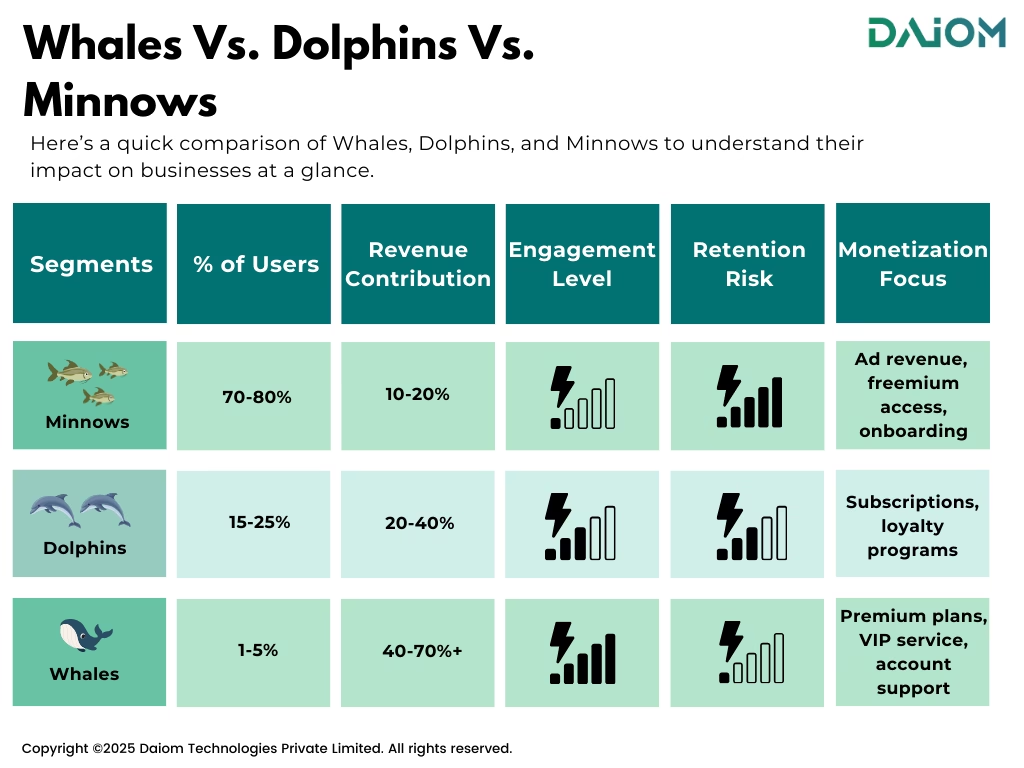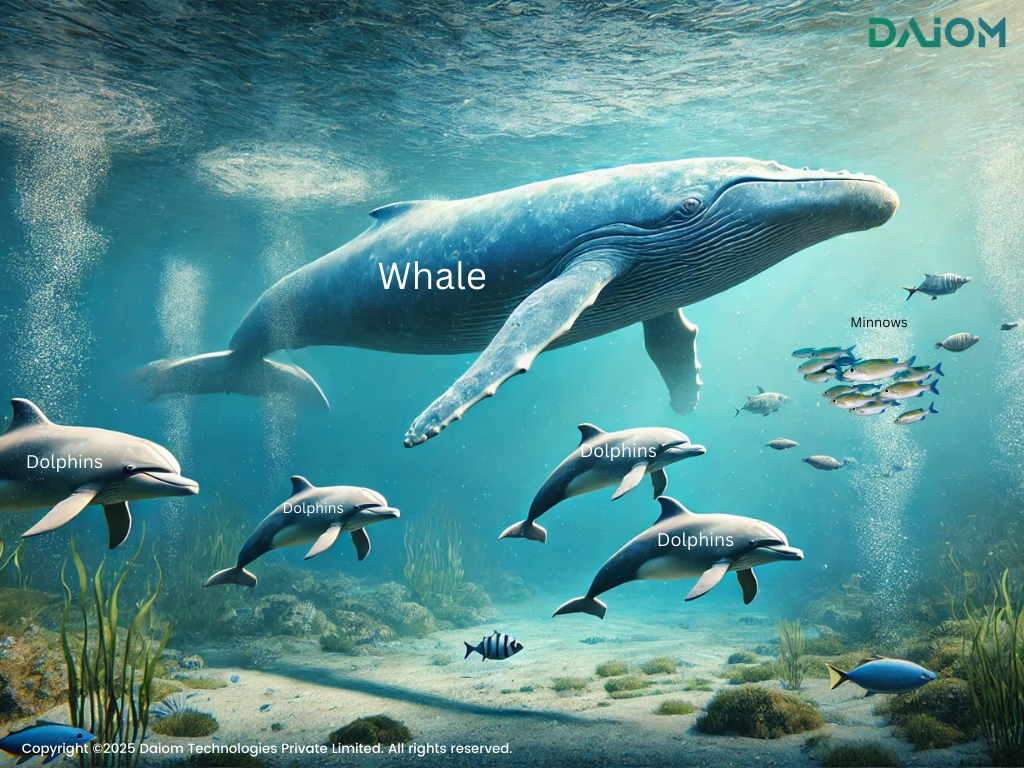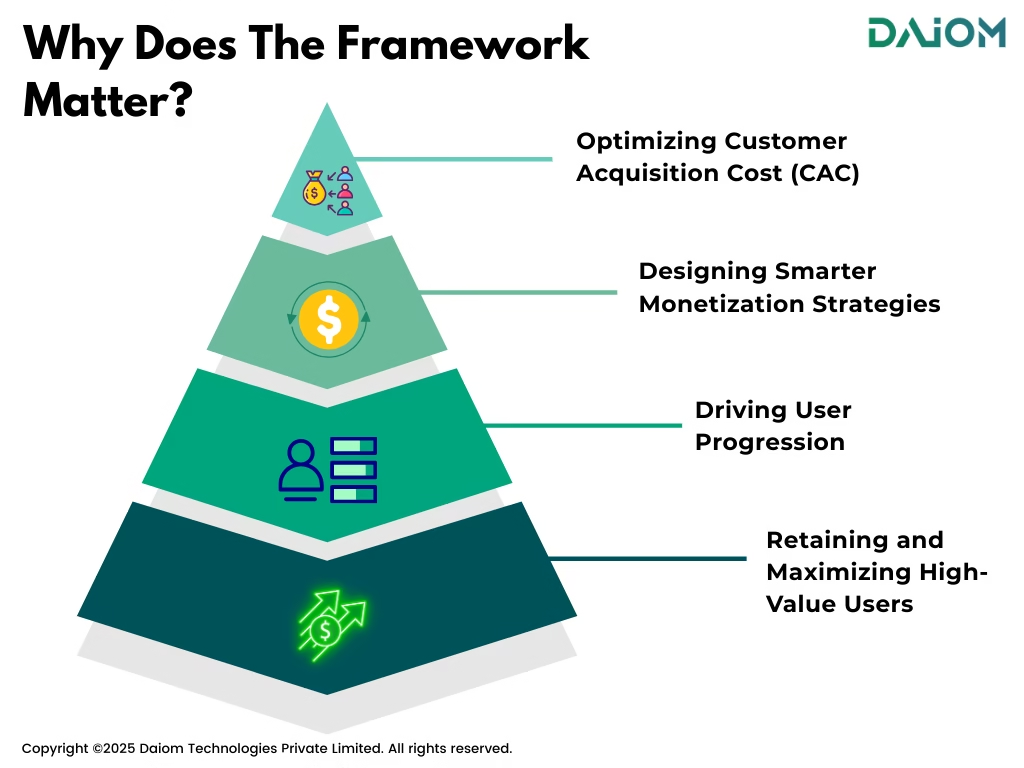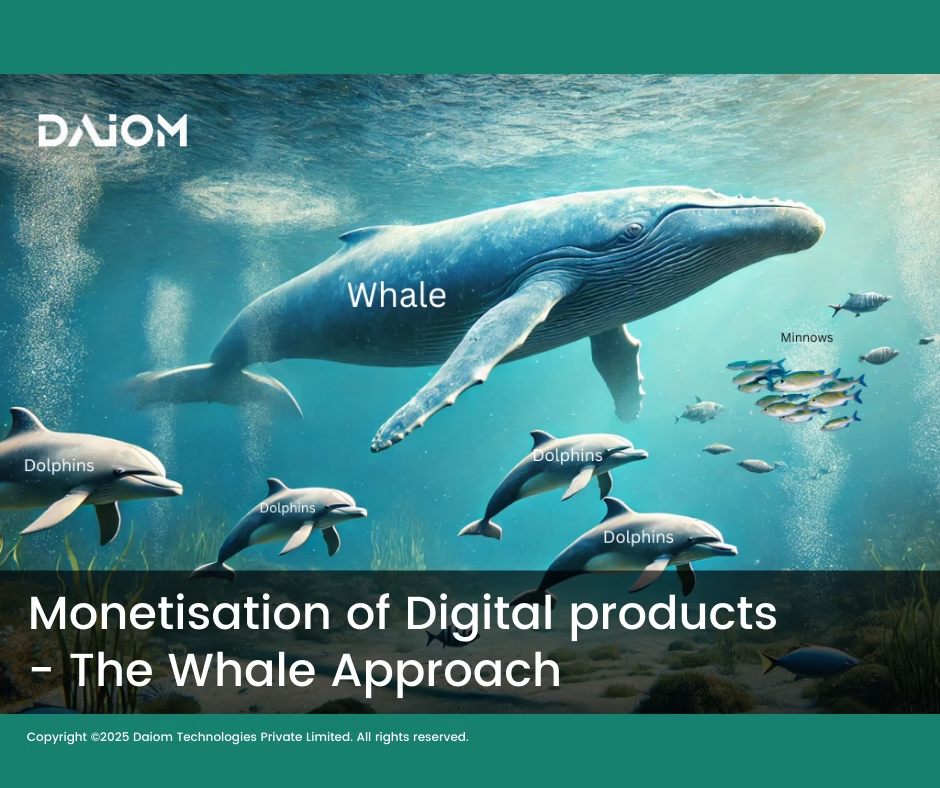Before monetization comes sustainability. Every company must figure out how to keep its product running while delivering value.
Not all users pay. Some products are completely free, while others are fully paid. Over time, companies have evolved to find the right monetization model—balancing free and premium offerings.
So, how do companies sustain and scale their products?
The key lies in understanding who actually drives revenue.
The Pareto Principle, also known as the 80/20 rule, suggests that a small fraction of inputs often drive the majority of outcomes.
In digital businesses, this pattern becomes even more pronounced. Research shows that as little as 1-5% of users can generate nearly 80% of a company’s revenue.
Despite this, many businesses continue to take a broad approach, treating all users the same. This often results in wasted marketing budgets, low engagement, and missed opportunities for sustainable growth.
Instead of trying to appeal to everyone equally, companies need to shift their focus toward the users who bring the most value.
A structured way to do this is by classifying users into three categories—Whales, Dolphins, and Minnows.
This segmentation helps businesses understand how different users contribute to their success and allows them to allocate resources more effectively. By identifying high-value users and customizing experiences to their needs, companies can build stronger relationships, improve retention, and drive long-term profitability.
Understanding and applying this approach is essential for businesses across industries, whether in SaaS, mobile apps, gaming, or eCommerce.
Let’s explore how this strategy works in practice.
80 percent of products, or customers or employees, are only contributing 20 percent of profits.
Richard Koch, author of The 80/20 Principle
Table of Contents
- Where Does The Whales, Dolphins, and Minnows Framework Come From?
- Understanding User Segments: Minnows, Dolphins, and Whales
- Product Examples by Segment
- Why Does The Framework Matter?
- Case Studies: How Businesses Move Users Between Segments
- How Businesses Can Use the Whales, Dolphins, and Minnows Framework?
- Final Words & Let’s Connect
1. Where Does The Whales, Dolphins, and Minnows Framework Come From?
The Whales, Dolphins, and Minnows framework started in the gaming and gambling industries. Casinos discovered that a small number of high-spending gamblers, called “whales,” brought in most of their revenue. To keep these players engaged, casinos offered them VIP services, special rewards, and exclusive experiences.
Later, the idea spread to mobile gaming. Games like PUBG, Clash of Clans, and Candy Crush run on a freemium model, where most players play for free, but a small group—less than 5%—spends money on in-game purchases. These “whales” buy character upgrades, virtual goods, and premium features, making them the biggest source of revenue.
Over time, other industries started using this approach. Freemium SaaS companies use it to identify free users who might upgrade to paid plans. Ecommerce businesses track their highest-spending customers to offer special deals. Streaming services analyze engagement to keep their most loyal subscribers.
Today, businesses across different industries use the Whales, Dolphins, and Minnows model to understand customer value, focus their marketing, and improve their products.
2. Understanding User Segments: Minnows, Dolphins, and Whales
Every digital business has different types of users, each with varying levels of engagement and spending habits. To better understand these patterns, we can categorize users into three key groups—Minnows, Dolphins, and Whales.

Each plays a distinct role in a company’s revenue strategy, and knowing how to engage them can help businesses maximize growth.

2.1 Whales: The High-Value Power Users
Whales are the rarest yet most valuable users, contributing the majority of a company’s revenue. These power users rely heavily on the product for professional or personal needs and are willing to pay a premium for added value.
Make up just 1–5% of users
Generate 40–70% (or more) of total revenue
Use the product daily or multiple times per day
Subscribe to premium, high-tier, or custom enterprise plans
For example, in Dream11, high-value fantasy sports players invest heavily in multiple contests, making them key contributors to the platform’s earnings. To retain whales, businesses must provide exclusive perks, premium features, and VIP support to enhance their experience and ensure long-term loyalty.
2.2 Dolphins: The Loyal, Consistent Spenders
Dolphins form the backbone of a company’s monetization strategy. They are more engaged than minnows and spend regularly, whether through subscriptions, in-app purchases, or mid-tier plans.
Make up 15–25% of users
Generate 20–40% of revenue
Engage weekly or daily
Often subscribe to mid-tier plans or make occasional purchases
A great example is Zomato Gold subscribers, who consistently order food and prefer premium features like discounts on dining and free deliveries. Businesses can retain dolphins by offering loyalty programs, personalized marketing, and subscription bundles that encourage repeated spending.
2.3 Minnows: The Majority, but Low-Value Contributors
Minnows are the largest group but contribute the least to revenue. They typically engage with a product occasionally, taking advantage of free trials, discounts, or ad-supported models.
Comprise 70–80% of total users
Contribute only 10–20% of revenue
Engage sporadically, mostly during deals or promotions
Respond best to discount-based offers and ad-supported models
For instance, in Hotstar, many users rely on the free, ad-supported tier rather than subscribing to the premium version. Since minnows have lower spending potential, businesses should focus on ad monetization, entry-level upsells, and seamless onboarding to gradually convert them into paying users.
3. Product Examples by Segment
Here are some of the real-world examples showcasing how various digital businesses segment users and implement monetization strategies.

4. Why Does The Framework Matter?
Not all users contribute equally to revenue, yet many businesses make the mistake of treating them the same.
By using the Whales, Dolphins, and Minnows framework, companies can optimize their customer acquisition, monetization strategies, and retention efforts to maximize profitability.
This segmentation approach ensures that businesses focus on the right users at the right time, driving sustainable growth.

4.1. Optimizing Customer Acquisition Cost (CAC)
Acquiring new users is expensive, but not all users bring the same value. A company spending the same marketing budget on minnows as on whales will struggle with profitability. Instead, businesses should:
- Invest strategically in acquiring dolphins and whales, as they provide higher lifetime value.
- Use lower-cost acquisition channels (organic, referrals, partnerships) for minnows rather than expensive paid campaigns.
- Target high-value users with personalized outreach rather than broad, generic marketing.
By optimizing CAC, businesses can improve return on investment (ROI) and ensure resources go toward acquiring the most profitable customers.
4.2. Designing Smarter Monetization Strategies
Each user segment has different spending behaviors. A one-size-fits-all monetization strategy can leave revenue on the table. Instead, businesses should:
- Offer basic upsells and ad-based monetization for minnows, who are hesitant to spend.
- Provide subscription bundles, loyalty programs, and occasional discounts to keep dolphins engaged.
- Create premium, high-ticket offerings, enterprise plans, and exclusive perks for whales, maximizing their value.
By aligning pricing and features with user behavior, businesses can increase revenue without alienating price-sensitive users.
4.3. Driving User Progression
Minnows may start as free users, but with the right nudges, they can become paying customers. The goal is to move users up the value chain, converting minnows into dolphins and dolphins into whales. Businesses can achieve this by:
- Gradually introducing paid features through freemium models.
- Using behavioral data to personalize upsell recommendations.
- Offering limited-time promotions to encourage first-time purchases.
By guiding users toward deeper engagement, businesses can increase customer lifetime value (LTV) over time.
Read more – Metric of the Week: Customer Lifetime Value (CLV)
4.4. Retaining and Maximizing High-Value Users
Whales drive a disproportionate amount of revenue, so keeping them engaged is critical. Losing a whale can significantly impact a company’s bottom line. To retain them, businesses should:
- Provide priority support, VIP experiences, and exclusive content to make them feel valued.
- Offer early access to features and personalized onboarding to maintain long-term engagement.
- Continuously analyze usage patterns to predict churn and intervene before they leave.
Since whales are highly engaged and rely on the product, a strong retention strategy ensures they stay and keep spending.
5. Case Studies: How Businesses Moved Users Between Segments?
Successful companies don’t just accept user distribution—they actively shape it. By strategically guiding minnows into dolphins and dolphins into whales, businesses can maximize both engagement and revenue.
Let’s look at how Dream11, Spotify, and Netflix used the Whales, Dolphins, and Minnows framework to grow their businesses.

5.1 Dream11: Converting Dolphins into Whales
Dream11, India’s largest fantasy sports platform, started with a large base of casual users who played free or low-stakes games. The challenge was turning these players into high-value users willing to spend more.
Initial Stage: Many users (minnows) played free contests, while dolphins made occasional paid entries.
Strategic Move: Introduced high-stakes contests, loyalty programs, and exclusive rewards for top players, encouraging dolphins to spend more.
Outcome: A thriving whale ecosystem, where top fantasy players contribute a significant share of revenue through frequent and high-value entries.
5.2 Spotify: Turning Minnows into Dolphins and Whales
When Spotify launched, most users were freemium listeners who streamed music for free but generated minimal ad revenue. To shift this balance, Spotify introduced Premium plans, family subscriptions, and student discounts.
Initial Stage: A large base of minnows using the free plan.
Strategic Move: Introduced affordable subscription tiers that made premium access more appealing.
Outcome: Built a strong dolphin and whale ecosystem, with millions of paying users driving sustainable revenue.
5.3 Netflix: Expanded Monetization Through Tiered Pricing
Netflix started with a single subscription model, treating all users equally. While effective at first, it limited revenue potential. By introducing tiered pricing (Mobile, HD, and Premium plans), Netflix optimized for different user behaviors.
Initial Stage: A flat subscription model where all users paid the same amount.
Strategic Move: Introduced lower-cost mobile plans for minnows while adding high-value premium plans for whales (offering 4K streaming and multiple devices).
Outcome: Successfully monetized all segments, expanding revenue while keeping a broad user base.
6. How Businesses Can Use the Whales, Dolphins, and Minnows Framework?
Businesses can apply this framework to refine their user strategy, optimize revenue, and improve retention. Instead of treating all users the same, companies can focus on behavior-driven segmentation to personalize experiences and maximize value.
- Segment users by behavior: Identify patterns in engagement, spending, and feature usage.
- Match monetization models: Use ad-supported revenue for minnows, subscriptions for dolphins, and high-touch services for whales.
- Create paths for progression: Design user journeys that encourage minnows to become dolphins and whales.
- Customize communication: Use targeted messaging—educational content for minnows, loyalty perks for dolphins, and VIP treatment for whales.
- Prioritize product development: Focus on features that enhance retention and appeal to high-value users.
7. Final Words
The Whales, Dolphins, and Minnows framework offers a clear way to understand user value, optimize monetization, and drive retention. No matter the industry—SaaS, gaming, ecommerce, or subscription businesses—identifying and nurturing the right segments can make all the difference.
The key is not just knowing who your users are, but how they behave and contribute to your growth. By applying this model strategically, businesses can create smarter pricing, better engagement, and sustainable revenue streams.
If you’re looking to refine your monetization strategy or scale your product effectively, let’s connect and explore how this approach can work for you.
If you’d like to discuss how we can help enhance your product monetization strategies, we’d be happy to set up a consultation call. Feel free to reach out to us at alibha@daiom.in
For more informative content and blog, follow and stay tuned to DAiOM.
Subscribe to our NEWSLETTER!


